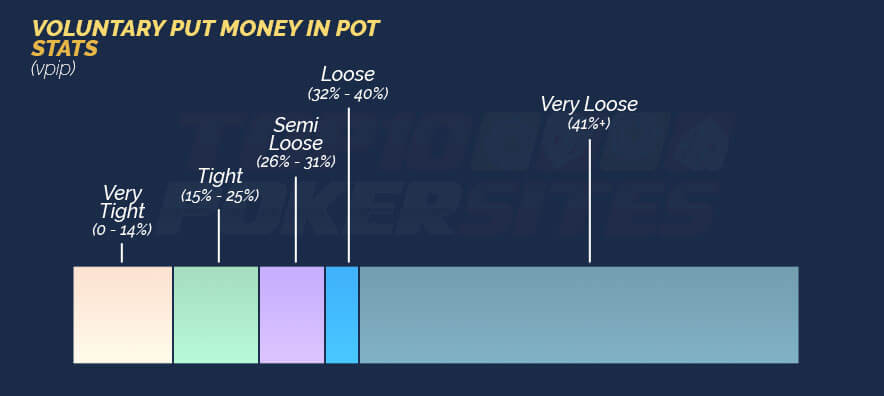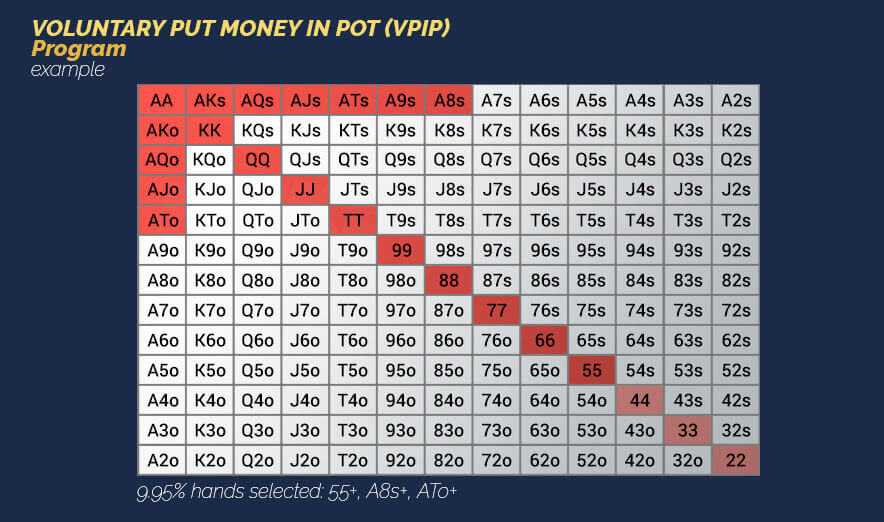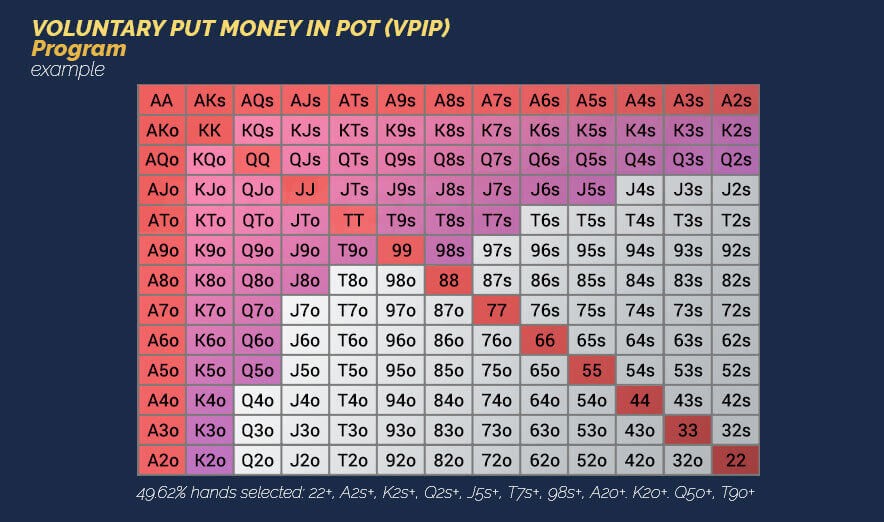What Is Voluntarily Put Money in Pot in Poker (VPIP)?
Voluntary Put money In Pot is an integral part of your poker stats. In this guide, you'll learn what it is and how you can play against it.

Poker statistics are among the many mysteries surrounding this game. Nevertheless, they’re a cornerstone of poker strategy and necessary for skill development. To that end, this article will discuss one of the most important poker stats — voluntarily put in pot.
If you’ve never heard about it before and want to know more, stay tuned. We’ll explore VPIP, how it differs in live and online games, and how to play against it.
Voluntary Put Money in Pot in Poker Explained
Voluntarily put money in pot or VPIP (pronounced “vee-pip”) is a term that refers to an important poker stat. It describes how often a player voluntarily — when not in blinds — decides to put money in the pot pre-flop, regardless of whether they’re calling or raising.
VPIP is expressed in percentages, and it’s unique to a player and a session. For instance, if you play a hundred hands per session and invest chips into the pot for 20 hands, your VPIP would be 20% for that session.
The VPIP percentage is used to measure how “tight” or “loose” a player is:
- Tight players play very few hands per session, and those hands are typically quite strong. They have low VPIPs.
- Loose players tend to play most of their hands and rarely refrain from putting money in the pot. They have high VPIPs.
Generally speaking, high VPIP would be anything over 40%+, and low VPIP would be anything below this value. However, this estimate depends on a few other factors.
Players can confuse VPIP with PFR, but the two refer to different stats. PFR, or pre-flop raiser, is a narrower concept and pertains to aggressive pre-flop actions. It measures only how much a player raises pre-flop, while VPIP refers to both raising and calling. As a result, a player’s VPIP is always higher than their PFR.
VPIP in Live and Online Poker Games
Voluntary put money in pot calculations have more weight for online than live poker games. The reason lies in the difficulty that’s involved in making these calculations. Online players can use software to calculate the VPIP frequency of their opponents. So, they don’t have to put in any additional effort to take advantage of VPIP.
Some better-known programs that calculate VPIP include Holdem Manager or Poker Tracker. They let you lay their HUD over your poker client and provide various poker stats about you and your opponents’ play, including VPIP.
You can see examples of these software analyses in the pictures below.
Estimating VPIP in live games is a completely different matter. You’d have to do all the calculations manually, which is nearly impossible at a live 9-handed table. It would require a ton of time and brain power and take away from your play. So, getting precise results isn’t an option for live players.
However, that doesn’t mean live poker players can’t make any use of VPIP data. They can utilize VPIP basics to categorize players into “loose” and “tight” groups and adjust their play accordingly.
Their logic would be based on general statistics rather than math.
- A standard online player at a 6-handed table will have a VPIP between 20% and 25%
- A standard online player in a full-ring game will have a VPIP between 15% and 20%
If your opponents invest chips less often than that and choose their spots carefully, you can assume they have a strong hand, and vice versa.
How to Play Against High and Low VPIP
Now that you know how to differentiate between high and low VPIP, let’s discuss how you should play against it.
As mentioned, players with low VPIP tend to enter the pot only when they have strong holdings. Your play should align with theirs.
- Pick your spots carefully but don’t be afraid to use hands with the potential to hit big.
- Make sure you take advantage of their frequent folds in pre-flop.
- Open-raise aggressively whenever they act behind you. You should be able to steal a significant number of their blinds.
Players with high VPIP are more likely to enter the pot with various holdings. You shouldn’t show too much respect for their lines and stick to playing with hands at the top of their range.
Furthermore, enter the Post-flop with caution. Some loose players change their tune during this part of the game. If they suddenly tighten up, you’ll have a chance to steal the pot. On the other hand, if your opponents keep playing weak hands post-flop, you can get chips in wider for value.
Best Poker Rooms To Play Online Tournaments
My list of the best poker sites which I consider to be the best rooms to play in 2024:- 100% Legal & Licensed
- Verified Bonus
- Mobile Friendly
- Advertiser Disclosure
Kindly be aware that some links on Top 10 Poker Sites are affiliate links, for which we may earn a commission. Find out more on our terms & conditions
- Must be 18+ to participate.
Displayed 3 of 8 rooms
Conclusion
A player’s VPIP frequency is among the most valuable poker statistics elements. While it doesn’t have the same relevance for online and live poker games, it’s still important for poker strategy overall. It can help you understand your opponents’ playing style, optimize your game accordingly, and leave the table with a bigger profit.FAQs
What is VPIP?
VPIP or voluntarily put money in pot is a measure of how often a player enters the pot before the flop.
Why is VPIP important?
VPIP can tell you whether your opponent is loose or tight. This information will help you analyze their gameplay and choose the best course of action.
What’s the difference between VPIP and PFR?
VPIP is the percentage of how often a player invests chips in the pot pre-flop, regardless of whether they’re raising or calling. PFR or pre-flop raiser only measures the percentage the player raises pre-flop. Players tend to use both of these stats to gain insight into their opponent’s play and strategy.
What’s a good VPIP?
Various factors decide a good VPIP percentage in the game. However, the rule of thumb is that you shouldn’t play more than 15–20% of your hands in a full-ring poker game, or you’ll become too loose.






